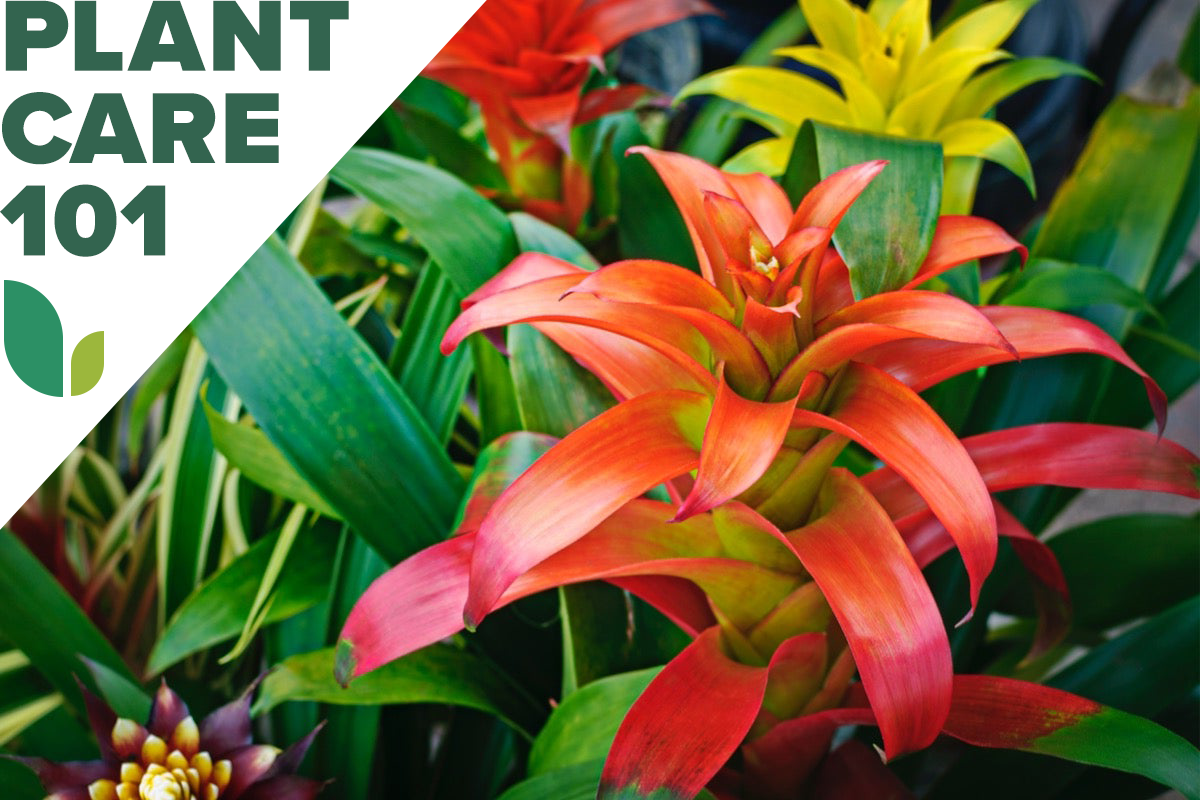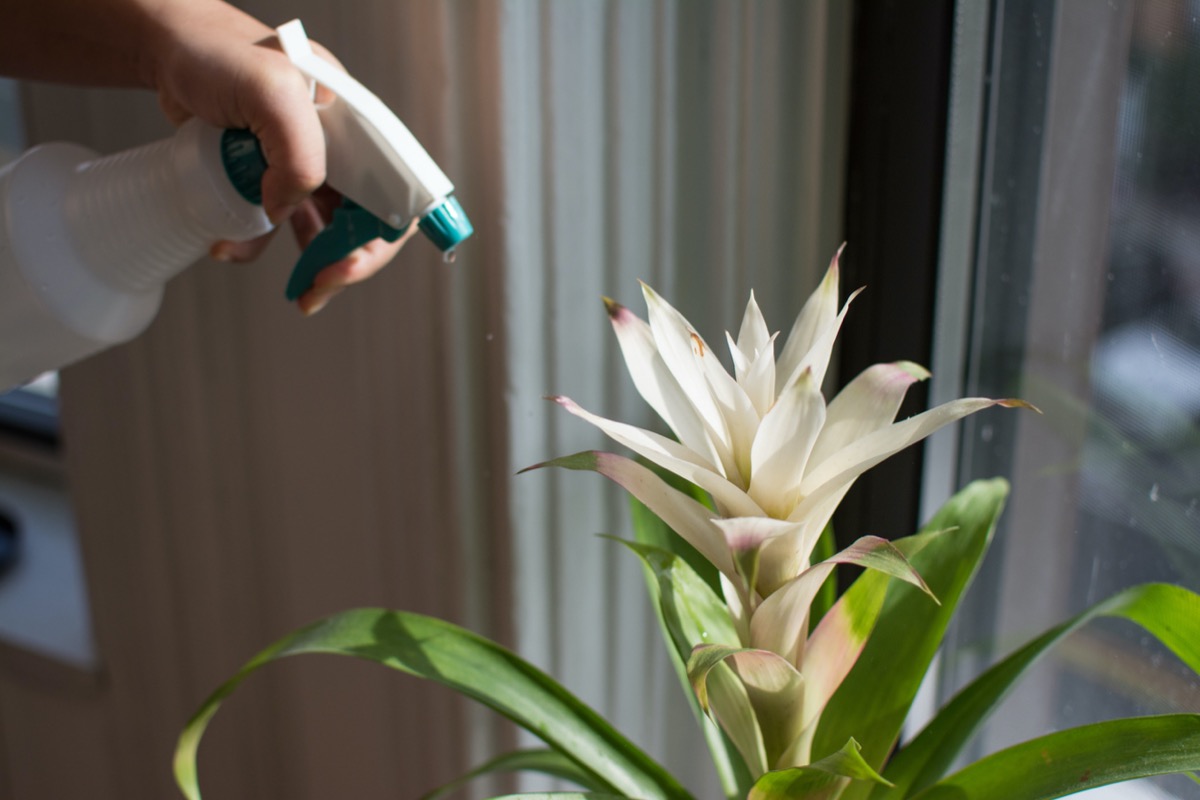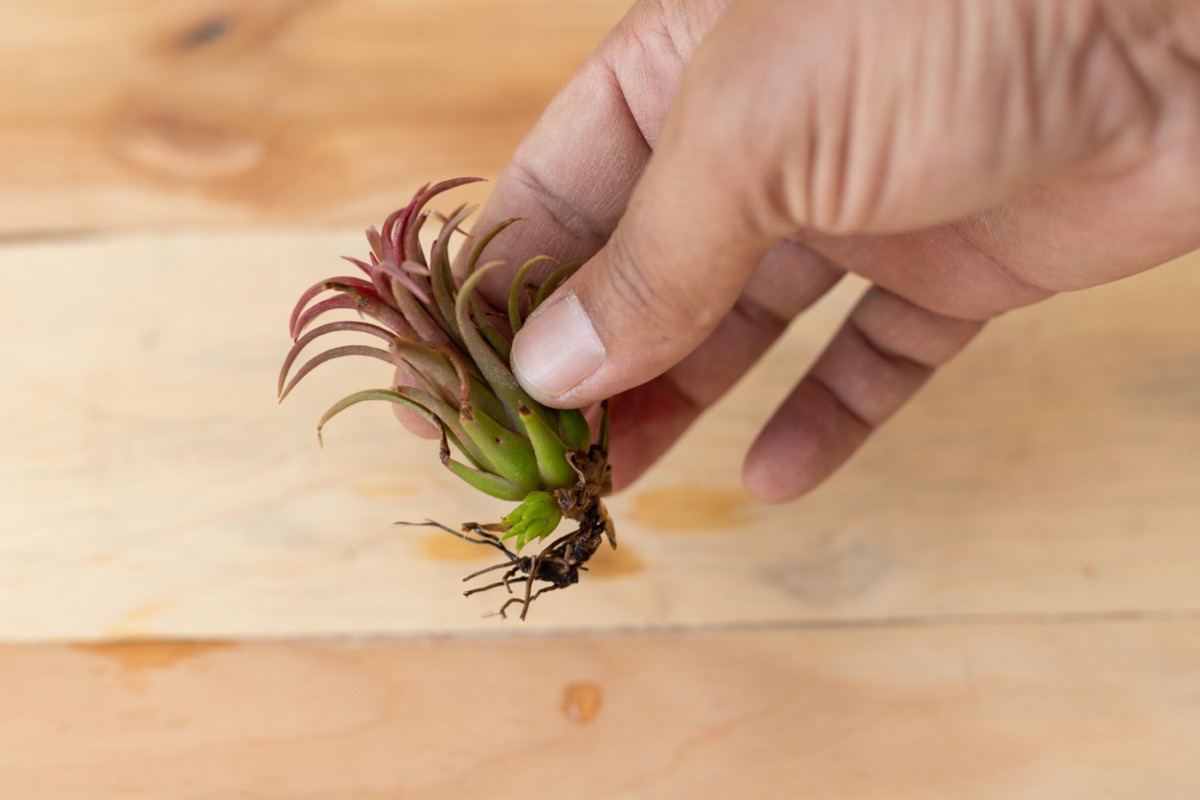

We may earn revenue from the products available on this page and participate in affiliate programs. Learn More ›
The bromeliad plant family is a large one. Although the Spanish moss native to parts of the Southern U.S. is considered a bromeliad, most members of that pineapple family (Bromeliaceae) cling to trees, rocks, or the forest floor in South American rainforests. The University of Wisconsin-Madison lists the “eight most commonly cultivated genera” as the Tillandsia (better known as the air plant), Aechmea, Billbergia, Cryptanthus, Dyckia, Guzmania, Neoregelia, and Vriesea.
With that in mind, your bromeliad care regimen will have to account for the fact that these plants won’t all have the exact same preferences—any more than your own family members do!
RELATED: These Are the Most Popular Houseplants in America
Bromeliad Care at a Glance
Common Name: Bromeliad
Scientific Name: Bromeliaceae family: Aechmea, Guzmania, Neoregelia, Vriesea, etc.
Soil: Bromeliad mix or orchid mix
Light: Partial sun
Water: Low
Food: Balanced all-purpose plant food
Temperature and Humidity: Indoor temperatures, high humidity
Propagation: Offsets
Safety: Nontoxic
Bromeliad Characteristics

Bromeliads vary widely in appearance. One of the only features they have in common is their rosette-forming foliage. Also, in plants with the showiest posies, the “flowers” are mostly made up of brightly colored bracts that the more muted actual blooms protrude from. But the shapes of those bracts differ; they are cone-shaped in Aechmea, for example, and paddle-shaped in Vriesea.
Some bromeliad types can hold water in the cup or “tank” at the center of their rosette; some can’t. But epiphytic varieties—which can grow on surfaces as well as in soil—absorb most of their damp and “dinner” through scales on their leaves rather than through their roots. That makes bromeliad care indoors and out a little different from most houseplant care routines. Having said that, there are also terrestrial bromeliads, such as Cryptanthus, which have a much closer relationship to soil than their relatives.
Types of Bromeliads
- Cartwheel Plant (Neoregelia carolinae ‘Tricolor’): Also called blushing bromeliad, this species boasts green leaves striped with cream and a cup that “blushes” bright red when it produces a few inconspicuous mauve blooms at its center.
- Flaming Sword Plant (Vriesea splendens): Otherwise known as the zebra bromeliad, this species’ foliage is decorated by horizontal maroon-brown stripes, and it raises a fiery orange flower spike from which protrude light-yellow blooms.
- Queen’s Tears (Billbergia nutans): Also known as the friendship plant because it’s so easy to propagate and share, the queen produces arching green foliage and dangling clusters of pink, green, purple, and yellow blooms that weep nectar.
- Scarlet Star (Guzmania lingulata): This star houseplant boasts glossy and strappy green foliage and a red bloom resembling a double and many-pointed star.
- Urn Plant (Aechmea fasciata): Also called the silver vase plant, this bromeliad is, indeed, silvery in color with a cone-shaped apricot-hued bloom.
Selecting Soil for Bromeliads
Because some bromeliads are epiphytes that grow on trees or rocks in the wild, they can easily rot in soggy soil. You’ll accordingly want to provide them with a well-draining acidic soil as part of your bromeliad plant care routine. Of course, that would ideally be a mix made especially for bromeliads.
Lacking bromeliad mix, you can also use orchid mix or an acidic “soil” you make yourself by mixing equal parts of peat moss, coarse sand, and pine fines (finely chopped pine bark). Whichever mix you use, keep in mind that its purpose is simply to anchor the roots in place for epiphytic types, since they won’t be deriving many nutrients from it.
RELATED: 11 Things You Didn’t Know That Houseplants Love
The Right Light
Although bromeliads like some sunlight, too much midday sun may burn them—especially those with the softest foliage, such as Guzmania. In “The Complete Houseplant Survival Manual,” Barbara Pleasant suggests the formula of “soft leaf, soft light; hard leaf, hard light.”
This means that the bromeliads with the stiffest leaves, such as Aechmea, should be placed on a west-facing windowsill, while those with softer leaves can remain on an east-facing one where the light is less intense. Many can also thrive in bright, indirect light.
How to Water Bromeliads

A standard bromeliad watering routine includes filling the foliage cup with water in the genera that have a “tank,” such as Aechmea, Guzmania, Neoregelia, and Vriesea. You should let a little of the water spill over and dampen the soil, but be careful to let the soil dry out before you water the plant again. That applies to Dyckia, too, even though it doesn’t have a cup. However, the similarly tankless and terrestrial Cryptanthus prefers for its soil to be evenly moist all the time.
Consider watering bromeliads with rainwater or spring water rather than hard tap water, which can spot the foliage. Remove and replace the water in the “tanks” at least once per week, either by dumping it out or by suctioning it out with a turkey baster. Never apply leaf oil to the plants because it can clog their scales.
Fertilizing Bromeliads
To fertilize your bromeliad houseplant, mix up a little all-purpose plant food at half the strength called for on the packaging. Then, pour it into a spray bottle and mist your plant’s foliage and tank with the nutrients. Repeat this once monthly during spring and summer, and only every other month during fall and winter. For terrestrial bromeliads, apply the fertilizer mix to the soil instead of the leaves.
When feeding mature plants, add a pinch of Epsom salt to the fertilizer mix to stimulate blooming. Another way to encourage a plant to flower is to place it inside a transparent bag with a ripe apple for a week or so to expose it to ethylene.
RELATED: This Purple Houseplant Is the First New Genus to Be Introduced in Decades—And You Can Get it Now
Setting the Temperature and Humidity
Bromeliads generally tolerate temperatures between 50 and 80 degrees Fahrenheit, but they prefer a drop of at least 10 degrees at night. That should occur naturally if you keep your plant outdoors during the summer months—perhaps indoors in winter, as well, if you turn down the thermostat at night.
Since many bromeliads absorb moisture through their “skin,” these plants also appreciate high humidity. You can help provide that by misting them every other day or so and keeping them on a shelf above a sink or in a humid room like the bathroom.
Propagating Bromeliads

A bromeliad flower can last for months. Sadly, however, after a bromeliad blooms—usually at about 3 to 4 years of age—it begins to die. Fortunately, it almost always makes a few offspring (offsets) before it bows out completely.
Wait until those offsets are one-third to one-half the size of their mother plant before you remove the cluster from its container. Cut the new plants away from the fading one with a sharp sterilized knife, and give each one its own pot. Or, you just can leave the offsets in the original pot and cut back the parent as it perishes if you prefer, though the pot may eventually become overcrowded that way.
Safety Considerations
Bromeliads aren’t toxic to pets or people, but some do have spines that can break skin. Additionally, bromeliad sap can cause skin irritation for some people—especially those with a latex allergy.
Bromeliad plants tend to get top-heavy, too, since their undersized root systems allow them to be grown in small pots. Therefore, they could potentially tip, topple, and tumble down onto whatever (or whomever) is below them. Make sure their containers are adequately sized without being large enough to cause root rot.
Potential Pests and Diseases
Any instructions on how to care for a bromeliad have to acknowledge the plants’ tendency to rot when grown in soil. In the wild, of course, epiphytic types’ roots are seldom encased in anything. If your plant begins to look rotten to the core, it might be too late to save it. However, you can try dumping out all the water in the plant’s cup and allowing the soil to dry out as well. In the future, you might want to try growing your bromeliads without soil instead.
Should your plant become infested with scale- or cotton-like bugs (most likely scale insects and mealybugs, respectively), you can scrub off the scales with a damp, lint-free cloth and/or kill mealybugs with a cotton swab dipped in rubbing alcohol.
RELATED: 15 Essentials for Beginner Plant Parents: What Every New Plant Owner Needs
FAQs About Bromeliad Care
Below you’ll find a few more helpful hints on how to care for bromeliads. Because there are so many genera contained in the bromeliad family, it’s a good idea to further research your particular plant to see if it has requirements not covered here.
Q. How often do you water a bromeliad plant?
Always keep water in the plant’s cup for “tank” types, but wait until its soil is dry to water that soil again.
Q. Do bromeliads need sun or shade?
They prefer partial sun, which means sun only in the morning or only in the afternoon rather than all day.
Q. Do bromeliads only flower once?
Yes, the original plant will only flower once before dying, but it usually produces offsets through self-propagation.
Q. What do you do with a bromeliad after it blooms?
Wait until it produces offsets at least one-third to one-half its size before you cut the original plant back. If you prefer, you can cut off those offsets and pot them separately.
Q. Should I mist my bromeliad?
Yes, epiphytic bromeliads should be misted frequently, since they absorb most of their moisture through their foliage rather than their roots.
Q. How do I know if my bromeliad is healthy?
If the plant looks vibrant, without any brown spots or browning or yellowing of its foliage, it’s probably healthy.
Looking for more showy and challenging plants? Check out our guides on caring for bird of paradise, hoya, and croton.
